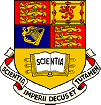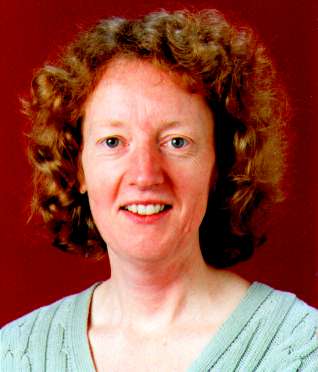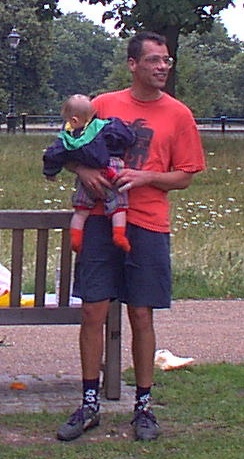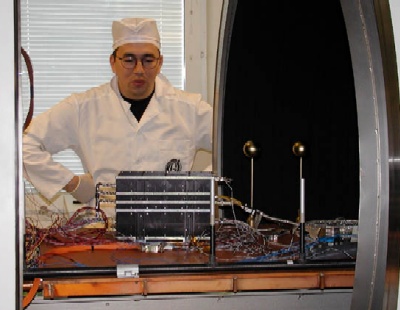
 |
|
News Page |

August 2001 |
This month's news stories:Professor Joanna HaighRalf Toumi promoted to Reader Rosetta testing in Sweden |
 Joanna D. Haigh, Professor of Atmospheric Physics
Joanna D. Haigh, Professor of Atmospheric PhysicsEveryone in SPAT was delighted, I know, to learn that Jo Haigh has been promoted in this year's staff review. So! She is only the second female Professor in Physics at Imperial College, and the only female Professor of Atmospheric Physics (to my knowledge) in Britain! In fact, there can't be that many in the world!? Well, SPAT has always been a special group, and now it is even more so!
The promotion is thoroughly deserved; Jo is an exceptional scientist, and a really nice person as well. Over the past 5 years, she has been invited to give talks at no less than 24 conferences or seminars, at places ranging from Sweden to Argentina, San Francisco to Berlin, and Birmingham to Reading. She has published in many journals, including Science and Nature, and has been quite a 'media celeb.' at times, making broadcasts on TV and radio which have been broadcast all over the world. She has been in demand on numerous international panels and reviews, including the IPCC, NASA programmes, the International Radiation Commission, and at home on the Council and as QJ editor of the Royal Meteorological Society.
Jo did her first degree at Oxford, in what at the time was far and away the leading department of atmospheric physics, and graduated in 1975. She then did a M.Sc. in Meteorology here at Imperial, before going back to Oxford to do her D.Phil, finishing that in 1980. She then took up a post-doc. position at Oxford, before getting a Lecturership in Remote Sensing back here again at IC. During this period she worked with a well-known figure at the time, Dr. Garry Hunt, which I know was 'an experience'! In 1990 Jo became a Lecturer in Atmospheric Physics. Shortly after this, as Ralf pointed out at our little party the other day, Jo was the sole remaining representative of a proud tradition at IC in meteorology and atmospheric physics, which at one stage between the war and the 1960's included even a separate Department of Meteorology.
From that point, where she was the smallest possible number of academic staff that can represent a 'group' (i.e. one), Jo has played a big role in the build up again of atmospheric physics here at College. I am deeply grateful for all her support and hard work, as she, Ralf and I, with an awful lot of help from our friends in the new group, have done that, and I am proud of a colleague that has now received the recognition that she completely deserves. One final note: knowing how such efforts are impossible without a supportive and loving family, our congratulations should also extend to Jo's husband Paul, also an academic: major contributions from him, I know.
Well done, Jo!
John Harries 17th July 2001
 | |
Ralf taking a break from the annual Space v. Atmos. football match with son Adam. |
Two lots of good news at one time is pretty rare, but that's what we enjoyed last week when the HoD, Professor John Pendry, brought down the news of Ralf's promotion to Reader, at the same time as news of Jo's promotion. Ralf Toumi is a very gifted young scientist, always thinking ahead of the field, looking for the 'interesting bits' in the science, a sure sign of an excellent researcher. At just 35, his promotion is very early, in recognition of this excellence.
Ralf did his first degree here at Imperial, in the Chemistry Department. He then went to work for his Ph.D. with a good friend of both of us, John Pyle at Cambridge, in the Department of Chemistry there. John's group is engaged in stratospheric chemistry and physics. Ralf produced a very interesting thesis entitled 'Testing photochemical theories of stratospheric ozone', a topic I had done some work on, and I really got to know Ralf for the first time when I was asked to be his external examiner! I recall that it was a fairly relaxed, no-problems sort of viva! Still, Ralf had obeyed rule No 1 (always quote some of your examiner's papers, however much you have to twist your text to do so), so he was OK!
Ralf then was appointed as a temporary lecturer in the Chemistry Department at Cambridge in 1990, and in 1991 he also took up a College lecturership at Christ's College. So, all set for a life of imbibing ancient reds from the College wine cellar, and strolling around College grounds to work of the excess, you might think. But, strangely, no! He decided (encouraged strongly by yours truly!) to have a go for a new Lecturership that had been set up when I joined Imperial from Rutherford Laboratory in 1994. Since then, Ralf has played a full role with Jo and me, with lots of help from everyone in the Group, to build up the new Atmospheric Physics Group that we have today. Ralf's publication list now numbers over 50 papers, many of which have been highly original, ground-breaking pieces of work: one might mention his work on lightning-ozone-temperature feedback, on trends in stratospheric water vapour, and on the possibility of complex soot particle surfaces acting as a non-catalytic surface reagent. Ralf has worked closely and successfully with a large number of his research students to produce a large number of papers, and has shown originality and initiative not only in research, but also on the teaching front, introducing several innovative measures in written exams, and in the laboratory.
What a year Ralf has had! A new son, Adam (assisted in that, and everything else, of course, by Emma, Ralf's wife), numerous disturbed nights courtesy of Adam, a broken finger (from playing football: no comment about getting older!), and now promotion! Ralf is a great friend and colleague, and superb supervisor, a real asset to our Group, and I know that everyone joins me in saying:
Well done, Ralf!
John Harries 18th July 2001
 | |
The team of Rosetta testers, from left to right, Michael Ludlam, Chris Carr, Reine Gill (IRF-U) and Chris Lee, pause at the Arctic Circle on their way north to Kiruna. |
The Rosetta Plasma Consortium (RPC) made a big step forward in June, completing the Flight Model qualification tests. The ESA Rosetta mission, due for launch in 2003, is destined to rendevous with Comet P/Wirtanen in 2011. The Plasma Interface Unit (PIU), built in the Space and Atmospheric Physics group at Imperial College, is designed to act as an interface between the spacecraft and the five space plasma experiments in the RPC consortium. The qualification tests, lasting 4 weeks, took place in Sweden and were supported by Chris Carr, Michael Ludlam and Chris Lee from the Imperial College Rosetta team who flew out to Stockholm in early June. The support of the Swedish Institute of Space Physics (IRF), who built two of the five sensors in the consortium, helped guarantee the successful outcome of the tests. Michael Ludlam relates the story of the tests and the diverse locations where they were conducted...
The first test, vibration, was carried out in a packaging research company in Stockholm that had a vibration table we could use. They also do work for a whole myriad of other companies – we spent the day with hundreds of boxes of sweets that had been shaken on one of their machines. Unfortunately the main electronics box containing PIU, MAG (the magnetometer), MIP (Mutual Impedance Probe) and LAP (Langmuir Probe) did not pass and one of the cards required a swift replacement from Germany. Undaunted, we decided to carry on with our tests and return to Stockholm when we had completed the other tests.
Next we had to get to Kiruna..... We are used to travelling down the M4 to the Rutherford Appleton Lab in a dirty old van. It does the job, but it isn't very pleasant. The van that was hired for us in Sweden was luxury in comparison. Complete with comfy seats, CD player and ample space for stretching out your legs, we wanted to take it home with us. However it need not be said that the van did not look quite as luxurious when we arrived in Kiruna, 1200 km north of Uppsala. It took two days to drive up the coast to Sweden's most northerly town, 200km north of the artic circle. This meant that we had sunshine all day and all night. It is a very disorientating experience especially when your watch says 10pm and the sky looks bright enough to be 10am. Kiruna is home to the largest underground mine in the world and also a lot of space research. 30km from the town is ESRANGE where sounding rockets and balloons are launched into the atmosphere, ESA has a base station there and it is also the home of the Kiruna branch of IRF (They are responsible for the Ion Composition Analyser (ICA) instrument on RPC).
 | |
In Kiruna: Chris Lee checks the instruments before closing the thermal vacuum chamber. The MIP probe is in front, the LAP probes to the right and the electronics box (containing PIU) at back. |
From Kiruna we took the inland roads south to Östersund to carry out our Electromagnetic Compatibility testing (EMC). This is to check that we are not producing stray electric and magnetic fields that will affect the spacecraft or other instruments in the payload. It is also to check that we are not susceptible to EM noise ourselves. We were joined by the fifth member of the consortium the Ion Electron sensor (IES) from San Antonio in Texas for this test. Because it is a particle instrument we had to keep everything very clean to avoid damaging the sensitve sensors. The EMC tests took a week lasting from 9 in the morning to midnight most days. That should have been the final test for us, but because we had the vibration test to run again in Stockholm it meant another weekend's work. Thankfully though we passed the test second time round and could finally go home. To much relief of all of us!
Work is continuing on the RPC flight model which is due to be delivered to Aerospazio Alenia in Turin in Spetember.
Michael Ludlam 14th August 2001
View last month's news, older news or return to Space and Atmospheric Physics home page